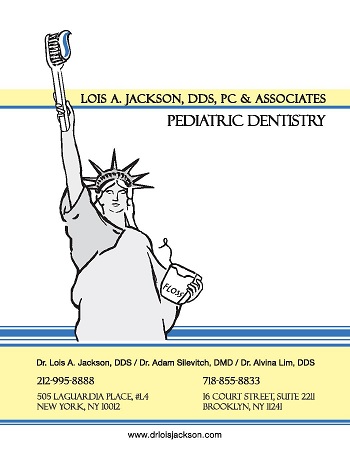 We recently held a new and exciting teleclass hosted by Dr. Adam Silevitch, DMD, Partner at Lois A. Jackson, DDS, PC and Associates.
We recently held a new and exciting teleclass hosted by Dr. Adam Silevitch, DMD, Partner at Lois A. Jackson, DDS, PC and Associates.
Dr. Adam answered questions regarding your childrens’ teeth, from the basics to some “hot button” topics.
In case you missed it, you can listen to the recorded teleclass here.
Some of the topics that Dr. Adam covered were: what to expect from my child’s first dental visit, what to do when my child has trauma to their front teeth, oral hygiene instruction for the home, foods to avoid, thumb and pacifier habits, and more.
Dr. Adam would like to share an important letter with the Mommybites community:
A Candy Primer for Parents: A Pediatric Dentist’s Perspective on Halloween Candy
Halloween has recently passed us by, but I’m sure much of the “candy stash” still is lingering in your households. Which means our kids will have a plethora of candy of all different varieties at their fingertips. Believe it or not, some varieties of candy are better for our children’s teeth than others. Also, most of us think that moderation is the solution, but as pediatric dentists, we beg to differ.
Bad Candy: Most pediatric dentists agree that gummy, chewy candies such as Gummy Bears, Sour Patch Kids, Tootsie Rolls, Laffy-Taffy, Starburst, Skittles, Swedish Fish, Jelly Bellies, and Now & Laters, (just to name a few) are the most damaging to our children’s teeth and existing fillings. This also goes for gummy vitamins, fruit leather, and dried fruit— even though these snacks are “healthy,” they can cause cavities as well.
These foods get stuck in the grooves of the teeth, and for some reason, our kids do not notice it. Can you believe it? When we get food stuck in our teeth, it drives us NUTS! Our theory is that children like the “never ending enjoyment of the flavor,” or as we like to say, “the gift that keeps on giving.” These foods remain on the teeth for a longer period of time, thereby creating the perfect environment for the germs to flourish and cavities to form. In addition, these sticky foods can dislodge protective sealants and existing fillings.
Good Treats: Chocolate, cookies, cake, ice cream and several other sweet treats are better for our children’s teeth, when compared to the candies mentioned above.
Chocolate, cookies, cake and ice cream don’t take forever to chew and they do not get lodged into the grooves of the teeth.
- Chocolate, by itself, has been shown to have a protective effect. This has been attributed to the presence of protective factors: calcium, phosphate, and the milk protein – casein.
- There’s a protective factor in cocoa itself, which is unlikely to override the negative effect of the high sugar content of chocolate on our teeth. That is why chocolate should only be a treat.
- Xylitol is a sweetener derived from plants. It helps to create a more unfavorable environment for the proliferation of germs in the mouth, thereby inhibiting the formation of cavities.
With children and treats, we always hear the phrase, “anything in moderation.” Well, yes, moderation is always good, but if they do eat sweets (especially during Halloween), have your children eat them all at once. Avoid ‘grazing’ over extended periods. For example, have a chocolate bar in one sitting, rather than constantly dipping into a bag of sweets over a period of hours or even days.
There are many things you can do with your buckets of Halloween candy. Below is a list of ideas:
- Trade it in for a special gift or toy your child has been wanting (have the “Halloween candy fairy” come, and leave the candy next to their bed at night)
- Buy it back from them for a reasonable price
- Donate it to the troops
- Donate it to local nursing homes, homeless shelters, group homes or even food banks (call first to see if they allow Halloween candy donations)
- Use it to make Halloween candy gingerbread houses, but GLUE it on, so they can’t eat it
- Test it in a science experiment
Don’t forget to keep those teeth clean, especially during Halloween and the Holiday Season!
Sincerely,
Dr. Adam Silevitch
Generously sponsored by
 Dr. Adam Silevitch earned his dental degree from the Boston University School of Dental Medicine before completing specialized post-graduate training in pediatric dentistry from Columbia University where he served as chief resident. He is an Attending Pediatric Dentist at New York Presbyterian Hospital-Columbia, as well as an Assistant Clinical Professor at Columbia University School of Dental Medicine. Dr. Silevitch is the Chair of the Children’s Dental Health Committee of the New York County Dental Society. Additionally, he is the Vice President of the New York Academy of Pediatric Dentistry and the Secretary/Treasurer of the Northeastern Society of Pediatric Dentistry. He has offices at 505 LaGuardia Place (Greenwhich Village) and 16 Court Street (Brooklyn Heights). More information about Dr. Adam and his pediatric dental practice can be found at www.drloisjackson.com or by calling (212) 995-8888.
Dr. Adam Silevitch earned his dental degree from the Boston University School of Dental Medicine before completing specialized post-graduate training in pediatric dentistry from Columbia University where he served as chief resident. He is an Attending Pediatric Dentist at New York Presbyterian Hospital-Columbia, as well as an Assistant Clinical Professor at Columbia University School of Dental Medicine. Dr. Silevitch is the Chair of the Children’s Dental Health Committee of the New York County Dental Society. Additionally, he is the Vice President of the New York Academy of Pediatric Dentistry and the Secretary/Treasurer of the Northeastern Society of Pediatric Dentistry. He has offices at 505 LaGuardia Place (Greenwhich Village) and 16 Court Street (Brooklyn Heights). More information about Dr. Adam and his pediatric dental practice can be found at www.drloisjackson.com or by calling (212) 995-8888.
Like what you read? Sign up for our free newsletter so you can be informed of the latest FREE webinars & teleclasses, parenting articles, & weekly raffles.
The views and opinions expressed on this blog are purely the blog contributor’s. Any product claim, statistic, quote or other representation about a product or service should be verified with the manufacturer or provider. Writers may have conflicts of interest, and their opinions are their own.



